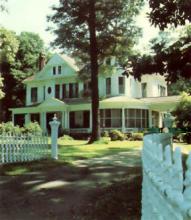The Biggs Home
The Home of Martha and Earnest Biggs is an outstanding example of Queen Ann-style architecture. It was built in 1893 for Joseph Bennett Bell, the son-in-law of Merrill Pratt, nephew of town founder Daniel Pratt. The Biggs family purchased the home in 1970 when Biggs, a retired lieutenant colonel, was stationed at Maxwell Air Force Base. The painstaking restoration of the house has been a labor of love for the Biggs family.
The Biggs home (or Bell House) has many unique features, including a wrap-around porch with Doric column supports and turned balustrades.
Other features of the Biggs home include: oak double front doors, a gabled entranceway, supported by paired ionic columns and elaborately decorated with garlands of flowers and ribbon motifs. All the main rooms on the first level have oak floors with parquet borders. Sliding oak double doors separate the formal parlor and the dining room which boasts a renaissance-revival coffered ceiling of dark wood and its original brass chandelier. A demi-octaganol bay window is graced by a leaded glass window.
The Bell House is also significant as its design has been attributed to prominent architect Frank Lockwood (1869-1936), a native of New Jersey.
Joseph Bennett Bell, the son of Jonathan Ezekiel and Georgiana Bell, was born in Greenville, Butler County, Alabama, in 1859. He was raised in Greenville and then moved to Montgomery where he obtained a job as a clerk at a hardware store. In 1889 Bell married Mary Pratt, daughter of Julia and Merrill Pratt, who was the nephew of Daniel Pratt, town founder of Prattville. Bell moved to Prattville in early 1890 and became a departmental manager for the Daniel Pratt Gin Company. In 1893 the Bells constructed their magnificent home on the outskirts of Prattville.
By 1905 Joseph Bell was secretary for the Prattville Mercantile Company where he remained employed for many years. From 1911 until 1915 Bell was a member of the State Legislature as a representative from Autauga County and in April 1919 he was appointed probate judge for the county. He dies in 1937 and his wife, Mary Bell, continued to live in the home until her death in 1945.
The home was added to the National Register of Historic Places - NPS on July 17, 1997 and to the Alabama Register of Landmarks and Heritage on October 7, 1998.

